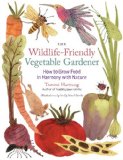A pamphlet from the Forest Service that emphasizes the value of wildlife in evaluating tree hazards. With just a little extra planning, hazard tree management programs can be highly beneficial to wildlife while maintaining the goals of the program. PDF
Keyword: Attracting wildlife
Garden Tip #30
Urban gardeners can do their part to conserve natural resources and restore the environment. The United States Department of Agriculture (USDA) Natural Resource Conservation Service has adapted agricultural practices in a new online publication called Backyard Conservation. Ten “chapters” with detailed instructions show how to build a backyard pond or wetland, how to promote wildlife and how to manage nutrients to prevent pollution of lakes and streams.
Garden Tip #133
Turn your garden into a little oasis for wildlife by growing plants that provide food for flying and buzzing creatures. The National Wildlife Foundation has articles on attracting bats, birds, bees, and other wild critters, as well as how to deal with the not-so-welcome.
After you’ve done your homework and planted wildlife feeding plants you might be ready to declare your yard a Wildlife Sanctuary. For an information package on becoming a backyard wildlife habitat manager send $10.00 to:
Washington Department of Fish and Wildlife,
Backyard Wildlife Sanctuary Program,
16018 Mill Creek Blvd,
Mill Creek, WA 98012. More information online.
The Wildlife-Friendly Vegetable Gardener

Here’s a book on growing edible crops with a unique perspective, that our vegetable gardens can be planned and designed to encourage or at least coexist peacefully with wildlife. For example, you may not want to share your lettuce with slugs and snails, but you can make the garden hospitable to predators that consume mollusks (such as birds, toads, lizards, foxes, and skunks).
Many of the author’s recommendations are common-sense organic approaches to gardening, such as starting with the soil: respect the microorganisms and other soil-dwelling life forms by not over-tilling and disturbing soil structure; observe nature in your garden (keep a journal or sketchbook) and get to know the insects—beneficial and nuisance—and their life cycles, and the other creatures who visit regularly or seasonally.
Design elements in a wildlife-friendly edible landscape include a “perennial backbone” of fruiting trees and shrubs (fruiting ornamentals that will attract birds and other animals and dissuade them from eating the fruit you’ve planted for your own consumption), a water source, and “decoy plants” planted as a border around plants you intend to harvest for yourself. Some of the ideas here require a fair amount of space: not every urban food gardener has room for a hedgerow, or can afford to plant extra (sacrificial!) rows of crops for hungry critters. Still, you may have room for a few ornamental plants that attract pollinators or a few aromatic shrubs and herbs (like curry plant, Helichrysum italicum, or santolina, or lavender) that may discourage browsing by deer and rabbits.
Deer and rabbits are grazers, so they may not wipe out an entire crop in one fell swoop in the way that gorgers (such as raccoons) or hoarders (like squirrels) can. My own garden has become a favorite spot for these creatures, and they do not even wait for fruit to ripen before absconding with it. I was familiar with many of the “scare tactics” and devices the author suggests, but I had not thought of putting rubber snakes around fruit tree branches to intimidate birds, squirrels, and small rodents, or perching fake owls atop poles to ward off nocturnal foragers.
The book concludes with design plans for edible gardens that are aesthetically pleasing, functional, and inviting for humans as well as other living beings.
Creating Your Own Healthy Habitat
Chapter 3, Audubon At Home in Seattle : Gardening for Life by National Audubon Society and the Seattle Audubon Society (2003). This chapter focuses on how to design a garden that will attract birds. It also includes a plant list.
Wildlife in the Garden
By Idaho Landscapes & Gardens, University of Idaho Extension. Gardens can be alive with songbirds and beneficial insects and many are visited by deer, rabbits, raccoons, skunks, voles, and even the occasional snake. On this page, you’ll find information to help you decide just how “wild” you’d like your garden to be and how to make it more-or less-so.
Designing for Wildlife
A compilation of suggested guidelines for making your landscape more wildlife friendly by PlantNative. These guidelines promote the essential habitat elements of food, cover, water, and places to raise young.
Wildlife Gardening Resource List
A list of the best books, articles and websites on gardening with wildlife.
Washington Native Plant Society: Landscaping with Native Plants for Wildlife
Native plants provide the food, shelter, and nesting habitat favored by our local wildlife. Make your garden a sanctuary for songbirds, hummingbirds, butterflies, bees and other wildlife using native plants.
Garden Tip #122
By November Seattle has usually had a good hard frost and most of our herbaceous (non-woody) perennials have either turned to mush or look a bit tattered. Before you give in to the temptation to cut back everything in sight, consider the advice of natural gardening advocates James Van Sweden, author of Gardening with Nature (Random House, 1997) and Jackie Bennett, author of The Wildlife Garden (David & Charles, 1993):
- Leaving seed heads and dead stems over the winter gives the garden winter interest, especially if we get some snow
- Seed heads from Black Eyed Susans, Echinacea, Larkspur and Evening primrose provide bird food
- Beneficial insects hibernate or over-winter as eggs on plant waste
- Marginally hardy plants like some salvias and lavenders benefit from the little bit of frost protection from the desiccated stems
On the other hand, sanitation is critical if your apples suffered from codling moth or scab or your roses suffered from black spot. Rake up and dispose of every single diseased leaf or infected fruit. Insect and disease organisms also over-winter on plant debris, so if you had a problem this year, start the treatment now with a thorough clean-up.